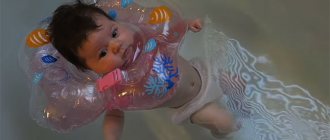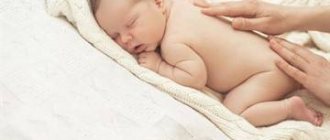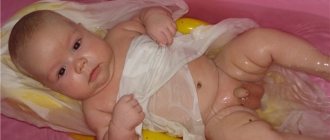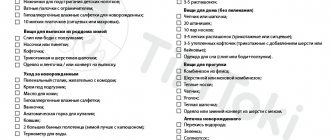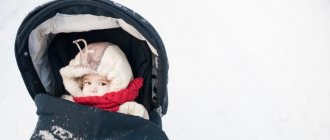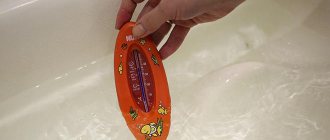The long-awaited moment has arrived. You and your baby are finally being discharged from the maternity hospital. While you were in the maternity hospital, the department staff helped you in caring for your child, and everything seemed clear and understandable. But when you are left at home, alone with your baby, everything seems much more difficult. So that you don’t get confused, let’s talk about newborn hygiene once again.
How to care for the umbilical wound
Why and why? The umbilical cord usually falls off on days 3-5 of the child's life. In its place remains the so-called “umbilical wound”, which heals by 10-14 days of life. In order to speed up the healing process and prevent infection from entering the wound, it is necessary to care for it daily. It is more convenient to treat the umbilical wound after bathing the child. It's not difficult at all, you can do it!
So, you will need: sterile cotton swabs, 3% hydrogen peroxide solution, salicylic alcohol.
- First you need to: remove rings and watches from your hands, wash your hands thoroughly.
- Unwaddle the baby, wash him if necessary and place him on the changing table.
- Using the thumb and forefinger of your left hand, spread the edges of the umbilical ring (with your index finger, pull the skin above the navel up towards the chest, and with your thumb, pull the skin under the navel down).
- Now take a bottle of peroxide in your right hand and drop 1-2 drops directly onto the umbilical wound. Wait 20-30 seconds until the peroxide fizzes and foams - it washes away the dead crusts, cleaning the wound. Continuing to hold the skin in the navel area with your left hand, take a sterile cotton swab with your right hand and dry the umbilical wound with gentle blotting movements. There is no need to try to remove those crusts that have not separated on their own - their time has not yet come. Perhaps they will disappear tomorrow or in a day.
- Take another cotton swab, dip it in salicylic alcohol, and spread the edges of the umbilical ring again. Gently but thoroughly blot the umbilical wound with the stick, and then wipe the skin around the navel in a circular motion.
- Let the alcohol dry for a few seconds
- That's all. You can put a diaper on your baby and swaddle him.
How to properly prepare a chamomile decoction for bathing a baby?
To make a chamomile decoction, you will need:
- dried grass;
- boiling water;
- utensils made of non-metallic material.
It is necessary to brew the herb in accordance with the established proportions, otherwise a too strong decoction can make the baby’s skin very dry and even cause peeling. And if the solution turns out to be too weak, then there will be no benefit from it.
Chamomile infusion for bathing
You should start preparing about two hours before your child starts bathing. Since chamomile has a calming effect, it is best used during an evening routine.
How to prepare a chamomile decoction for bathing:
- Place 2 tablespoons of dried herbs in a glass or porcelain bowl and add one liter of hot water;
- Cover tightly with a lid and wrap in a towel. Leave the resulting decoction for two hours so that it can brew;
- After the allotted time, the liquid must be filtered several times until there are no particles of herb left in it.
The proportional ratio of the amount of water and chamomile decoction in the bath should be 1 to 10 liters.
If you don’t have time to prepare a decoction, you can buy bagged chamomile at the pharmacy and attach the bags around the perimeter of the baby’s bathtub with clothespins . To maintain proportions, it is generally accepted that 1 sachet is equal to 1 tablespoon of dried herb.
Chamomile infusion for baby bathing
It will take more time to prepare the infusion. During this period, all beneficial properties will appear at the maximum level. If there are minor rashes and irritations, the infusion will be the best option for removing them.
How to prepare a chamomile infusion for bathing a baby:
- Pour 2 tablespoons of dried chamomile into 3 cups of hot water. A glass jar is suitable as a container for brewing;
- The resulting solution should be covered with a lid, wrapped in a towel and put in a warm place for 12 hours.
How to wash a newborn baby
Why and why? The skin of babies is much more delicate than that of adults, irritation and diaper rash occur very easily, so you need to wash the baby every time after he has had a bowel movement. In addition, keeping the skin clean helps your baby develop the first skills of neatness.
If you are away from home, you can use special baby wipes instead of washing, but you should not completely replace washing with such a simplified skin treatment.
A little trick. Babies tend to have a bowel movement after or during each feeding. This leads to the conclusion that washing before eating is a thankless task.
- The first thing you need to do is roll up your sleeves, remove rings and watches from your hands, adjust the temperature and pressure of running water. Prepare a thin diaper to dry the skin after washing. It is very convenient to just hang it on your shoulder and always have it at hand.
- Unwaddle your baby and remove his diaper.
- It is more comfortable to hold the baby with your left hand and wash it with your right.
- The boy is held face down when washing. Take the baby so that his chest lies across your forearm, while you hold his shoulder with the fingers of your left hand. Oddly enough, but hanging in this position, the baby does not experience the slightest discomfort.
- The girl needs to be washed only from front to back, so as not to contaminate her genitals. Place the child's back on the forearm of your hand, so that the head is on the bend of the elbow, and you will hold her left thigh with your fingers. This position allows you to securely hold the baby, and leaves you complete “freedom of action.”
- Wash your baby by scooping water into your palm using gentle movements from top to bottom, carefully removing dirt from the skin. It is especially important to wash all skin folds where dirt can accumulate and cause irritation. Do not use soap unless absolutely necessary; washing with soap once a week is sufficient.
- When washing the girl, there is no need to “rub” the genitals, since the mucous membrane is very delicate. In addition, overzealous washing removes the protective lubricant that protects the genitals from pathogens.
- After washing, dry your baby's skin. First, wrap the diaper over your baby's lower body and transfer him to the changing table. Then thoroughly blot the genitals, groin, buttocks and popliteal folds.
- If necessary (irritation), treat skin folds with a small amount of baby oil.
- Your baby is happy with life again. Now it would be good to “air out the butt” for 5-10 minutes before putting on a new diaper.
How to properly prepare a decoction
Brown-eyed parents gave birth to a blue-eyed child - probable reasons
Parents should know how to brew chamomile for bathing a newborn. The use of chamomile for medicinal and preventive purposes is very simple:
- medicinal raw materials are brewed in the required proportion;
- infused for a certain time;
- poured into a bathtub with water prepared for bathing the baby;
- the baby bathes in the water, being exposed to the healing effects of chamomile.
When preparing the decoction, the recommended proportions should be strictly observed.
How to brew
A baby bath with chamomile is a very simple event. Take two glasses of boiled water for two teaspoons of dry crushed inflorescences. The infusion time is at least one and a half hours, ideally two hours. If brewed chamomile is not used within five hours after it is prepared, it loses its medicinal properties.
How much to add
Parents often ask how much chamomile to brew for bathing newborns. The entire resulting broth is filtered through a sieve and added to the water prepared for bathing the child, and then stirred. This amount is quite enough for a therapeutic and preventive effect.
How to add
Under no circumstances should you add the broth to the bath when the child is already there - you may not be able to calculate the temperature. First, water is poured into the bath, then medicine is added, and then the temperature is measured. When the temperature reaches 37 degrees, the baby can be placed in the bath. A pediatrician or nurse can tell you how to bathe a newborn in chamomile.
Using filter packages
One filter bag purchased at a pharmacy is placed in a cup with 250 g. boiled water and infuse for an hour. Then the filter bag is thrown away and can no longer be brewed again. This method is convenient because the resulting medicine does not need to be filtered through a sieve, but can be immediately made into an infusion and poured into a bath. The filter bag should be brewed according to the instructions on the package.
Baby swims
Bathing a newborn
Why and why? Bathing a newborn (hygienic bath) is carried out for all healthy children after the umbilical remnant falls off. Before the umbilical wound heals, it is recommended to bathe the baby in boiled water or running water, but you need to add a solution of potassium permanganate (potassium permanganate) to it.
Until your baby is six months old, it is advisable to bathe him daily; in the second half of his life, you can do this every other day. As a rule, children really like to swim, because before birth, water was their natural element. In water, the muscles relax, the child feels comfortable and calm. The duration of bathing in the first year of life is 5-10 minutes. Washing with soap is carried out no more than once a week. It is advisable to bathe the child no earlier than an hour after feeding, preferably 10-15 minutes before evening feeding.
It is more convenient to bathe a newborn baby together; most often, the father is called upon to help, and in many families, bathing the baby is exclusively the father’s “honorable mission.” Large and reliable male hands hold the baby’s tiny body with amazing tenderness, which contributes to the emergence and development of close contact between the child and the father, who at these moments feels very needed. But if you have to do without an assistant, don’t worry, you can do it just fine on your own.
Important! If your baby is unwell, has a fever or signs of skin irritation, it is better to postpone bathing until you consult your pediatrician.
You will need: a baby bath, a jug of warm water for rinsing the baby, a special water thermometer, baby soap, a terry mitten, a large terry towel, a diaper, baby oil, a changing table with prepared clothes for the baby, cotton swabs with limiters or cotton swabs.
If the umbilical wound has not yet healed, prepare two containers with cold and hot boiled water or a solution of potassium permanganate to add to running water. The solution of potassium permanganate must be added to the water “drop by drop” until the water turns a faint pink color. Before using potassium permanganate, make sure that the crystals are completely dissolved, as getting a potassium permanganate crystal on the skin can cause a burn.
The air temperature in the room while bathing the child should be 22-24 degrees. You can bathe your baby in the bathroom, if it is spacious enough, or in the kitchen.
- First of all, you need to prepare the bath - wash with a brush and soap and rinse with boiling water. Place the bath in a stable, comfortable position and fill it ½ full with water. First pour cold and then hot water to avoid steam formation. Now you need to immerse the thermometer in water. The temperature of the water in the bath should be 37-37.5 degrees. Measuring the water temperature with your elbow is only possible if you have sufficient experience; a thermometer is always more reliable.
- Lay out the baby's clothes on the changing table, lay a towel on top, and place a diaper on it for wiping. However, you can put the diaper near the bath to make it more convenient for you to take it.
- Undress the child and, if necessary, wash him. Take the baby so that the head rests on the forearm of your left hand, and hold the baby’s left shoulder joint with your fingers (the thumb clasps the shoulder from above, place the other fingers in the armpit). Use your right hand to support the baby's buttocks and legs.
- Slowly immerse the baby in the bath: first the buttocks, then the legs and torso. Continue to support the baby's head with your left hand, leaving your right hand free for washing. The water level should reach the baby's armpits.
- Swing the child on the water back and forth, left and right. Your movements should be smooth and unhurried. Smile at your baby and talk to him affectionately.
- If you plan to wash the child with soap, then the “mitten” is put on the right hand. Lather your body using gentle circular motions and immediately rinse the soaped areas. First, wash your head from the forehead to the back of the head, then your neck, arms, chest, abdomen, legs. Rinse skin folds thoroughly. Lastly, wash your buttocks and genitals.
- Remove the baby from the water with its back facing up. Rinse your body and wash your baby's face with water from a jug. Place a diaper on the baby, place him on the changing table, and dry the skin with gentle blotting movements.
- Dry your ears with cotton swabs or cotton swabs.
- Lubricate the folds of the skin with baby oil. If necessary, treat the umbilical wound.
- Swaddle or dress your baby.
Now, to feel complete happiness, it would be nice for your baby to eat and sleep.
Features of bathing a child in chamomile decoction
At what age can a child be given pork?
In pediatrics, a decoction of the plant is used exclusively for external use as an addition to water procedures. Giving the infusion to a child internally is strictly prohibited, as this can cause serious poisoning.
What is it used for?
You can bathe your baby in a decoction of medicinal herbs if:
- the baby is bothered by diaper rash or skin manifestations of diathesis;
- the child suffers from itching caused by insect bites while outdoors;
- the baby sleeps poorly and is often restless at night;
- The baby suffers from intestinal colic.
The medicinal plant helps soothe itchy skin and also helps relieve muscle tension, thereby relieving intestinal colic.
Contraindications
If you use chamomile infusion correctly during bathing, there are no contraindications for use. You can prepare a healing bath not only for a child of the first year of life, but for children from one to three years old who suffer from skin diseases, chamomile can also be of great benefit. You can also apply lotions and compresses with a decoction to the affected areas. There can be only one contraindication: the use of medicinal raw materials collected in a contaminated place. In this case, the treatment will do much more harm than good.
Regular use of medicinal herbs while bathing gives good results
Morning toilet of a newborn
Why and why? We all know that “cleanliness is the key to health,” so every day we wash ourselves, brush our teeth, take a shower or bath. Without these usual hygiene procedures, a person feels uncomfortable. For a newborn baby, daily skin care is much more important than for an adult; in addition, the first habits of cleanliness begin to form unconsciously at such an early age.
The baby's daily toilet consists of washing, treating the eyes, nose, and skin folds. Until the umbilical cancer heals, it also needs to be treated daily. You need to wash your child after a night's sleep and during the day every time the child has had a bowel movement. The ears are treated as necessary in case of contamination and dried after each bathing. Children's nails are trimmed as they grow.
You will need: cotton pads (cosmetic pads), cotton wool for making flagella, baby oil or Vaseline, a container with warm boiled vodka, a container for used materials, scissors with rounded ends, cotton swabs with limiters, a set for treating the umbilical wound.
- First you need to remove rings and watches from your hands and wash your hands. Prepare everything you need: open a bottle of oil,
- wash the water container with soap, scald with boiling water, fill with warm boiled water,
- twist nasal flagella from small pieces of cotton wool, about 3 cm long and 2-3 mm in diameter,
- prepare a kit for treating the umbilical wound.
Now that you have everything at your fingertips, let's get down to business!
When are chamomile baths useful?
Carrying out such procedures is recommended not only in case of skin problems, but also as a preventive measure. On an ongoing basis, on the advice of a pediatrician, you should take chamomile baths for your baby if you have problems such as :
- eczema in a child;
- diaper rash;
- sores on the skin;
- rash and irritation;
- hypersensitivity of the skin;
- dermatitis;
- problems falling asleep at a certain time.
Washing and eye care
Washing a newborn baby is done with warm boiled water using cotton pads. Children over 3 months can be washed with running water.
Take a cotton pad, moisten it with water, squeeze lightly (so as not to drip). Wipe your baby's face in the following order: forehead, cheeks and, lastly, the area around the mouth. Discard this disc.
Then treat your eyes with separate cotton pads for each eye, moistened with warm boiled water, from the outer corner of the eye to the inner.
Take a dry cotton pad and dry your child's face in the same sequence.
How to properly brew herbs for bathing a child: video
Chamomile is one of the first herbs in which you can bathe your child. It affects the baby’s delicate skin with exactly the intensity necessary to treat rashes. There is nothing complicated about how to brew chamomile for bathing a newborn. The main thing is to maintain proportions and pay close attention to the baby’s feelings.
Read further:
Water temperature for bathing a newborn baby, should it be boiled? (video)
Line for bathing newborns - how to brew, how to bathe a child in the line?
How to bathe a newborn baby at home for the first time - video “first bath”
Bathing a newborn baby - how to bathe a baby correctly, how often?
Chamomile during breastfeeding - can a nursing mother drink chamomile tea?
Chamomile during pregnancy - how can you drink this medicine when you have a cold?
Care for skin folds
To treat skin folds, use baby or Vaseline oil. Ready-made baby wipes impregnated with oil are quite convenient. You can moisten a cotton pad with oil, or you can simply apply it to your palms.
Important! You cannot use oil and powder at the same time, because in this case the powder will roll into lumps, which can cause skin irritation and diaper rash.
First, lubricate the folds of the upper half of the body (from top to bottom) - behind the ears, cervical, axillary, elbow, wrist. Then, with another tampon, fold the lower half of the body (from bottom to top) - ankle, popliteal, inguinal, buttock.
Now, so that the baby does not look like an oil donut, excess oil from the skin needs to be removed with a dry cotton pad.
Contraindications for use
Although chamomile is a delicate remedy and acts very gently on the baby’s skin, even it can provoke a negative reaction. Typically this happens:
- if the proportions are not observed;
- if used incorrectly;
- due to the individual reaction of the newborn’s body.
It is not recommended to bathe your baby in chamomile if he has dry skin and flaky areas. If dryness appears after a bath with chamomile, you should apply a nourishing baby cream to the skin (Bepanten is also suitable) and temporarily stop using it.
It is also better to postpone phytobaths if the child has:
- rashes of unknown etiology;
- allergies, the cause of which has not yet been identified (this is not always a rash, there is an allergic runny nose, lacrimation and other manifestations);
- bleeding ulcers;
- hyperthermia.
Also take a break from using herbs a few days before and after vaccination.
A significant contraindication is individual intolerance. It is quite rare for chamomile, but before the first bath it is better to do a simple test: apply a drop of ready-made chamomile infusion (decoction) to the baby’s hand. If no reaction is observed after about 30 minutes, the herb can be used.
If the baby has no contraindications and he tolerates chamomile well, baths will have a beneficial effect and bring pleasure.
Ear care
The ears and external auditory canals should be dried from water after bathing. It is very convenient to use ready-made “ear” cotton swabs with limiters. If you don’t have them, you can make small tampons out of cotton wool. Dry your baby's ears with gentle blotting movements using separate swabs.
If discharge (earwax) has accumulated in the external auditory canal, you need to clean it using cotton swabs with limiters or cotton swabs soaked in Vaseline or baby oil. Insert the flagellum into the external auditory canal with careful rotational movements to a depth of no more than 0.5 cm. Use a separate flagellum for each ear canal.
Contraindications for use
Although chamomile is a delicate remedy and acts very gently on the baby’s skin, even it can provoke a negative reaction. Typically this happens:
- if the proportions are not observed;
- if used incorrectly;
- due to the individual reaction of the newborn’s body.
It is not recommended to bathe your baby in chamomile if he has dry skin and flaky areas. If dryness appears after a bath with chamomile, you should apply a nourishing baby cream to the skin (Bepanten is also suitable) and temporarily stop using it.
It is also better to postpone phytobaths if the child has:
- rashes of unknown etiology;
- allergies, the cause of which has not yet been identified (this is not always a rash, there is an allergic runny nose, lacrimation and other manifestations);
- bleeding ulcers;
- hyperthermia.
Also take a break from using herbs a few days before and after vaccination.
A significant contraindication is individual intolerance. It is quite rare for chamomile, but before the first bath it is better to do a simple test: apply a drop of ready-made chamomile infusion (decoction) to the baby’s hand. If no reaction is observed after about 30 minutes, the herb can be used.
If the baby has no contraindications and he tolerates chamomile well, baths will have a beneficial effect and bring pleasure.
Trimming nails
A newborn baby's nails need to be trimmed as they grow on his hands and feet to prevent the baby from scratching himself. Special children's scissors with rounded ends are convenient and safe.
A little trick. Many mothers are afraid of the thought that they will have to cut the nails on such tiny fingers that are constantly in motion. Therefore, everyone will be calmer if they do this “delicate work” when the baby is sleeping.
Take the child's hand so that only one finger remains free, on which you are going to trim the nail. Grab the finger with the thumb and index fingers of your left hand, holding it on both sides, and with the remaining fingers of your left hand you can hold the child’s other fingers.
Fingernails are trimmed in a semicircle, and toenails are trimmed in a straight line to avoid future problems such as ingrown toenails. You need to trim your nails with continuous movements of the scissors, and not “piece by piece.” Please check if there are any protruding sharp parts left on the nails.
Don’t forget to carefully collect the trimmed nails so that if they get lost in the folds of clothes and linen, they won’t injure your baby’s skin.
Benefits of chamomile
Chamomile is a popular plant with healing properties.
What are the benefits of chamomile for a baby?
Which chamomile to choose for baby's bath?
Preference should be given to herbs that are sold in pharmacies, since in this case there is a guarantee that the product is of high quality and safe for a newborn.
The beneficial properties of chamomile are a long list, here are some of them:
- promotes accelerated healing of small scratches and wounds on the baby’s skin, as it has a bactericidal effect;
- due to the presence of anti-inflammatory components, it dries out the rash and prevents its further spread;
- normalizes sleep;
- has a calming effect on the nervous system;
- strengthens the immune system.




